Introduction of suffix tree
This document discusses suffix trees, including their definition, important contributors, construction, implementation, and applications. Key points: - A suffix tree is a compressed trie representing all suffixes of a string. It allows efficient pattern matching in linear time. - Important contributors include Weiner (1973), McCreight (1976), Ukkonen (1995), and Farach (1997) who developed faster construction algorithms. - There are multiple ways to implement a suffix tree, including using sibling lists, hash maps, balanced search trees, or sorted arrays. External memory may be needed for very large trees. - Applications include fast substring search, longest common substring problems, and data compression. References provide more details on










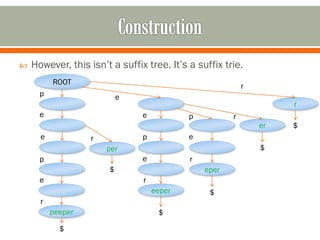
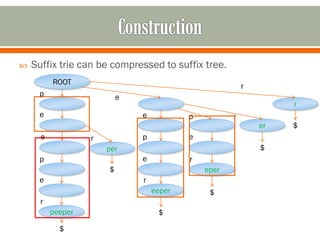
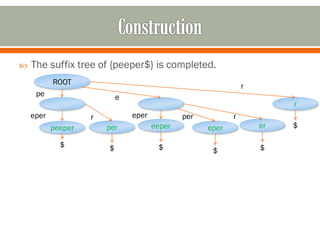
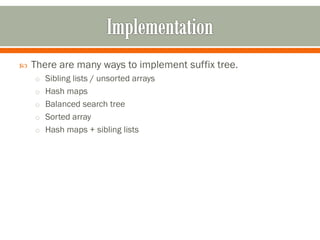
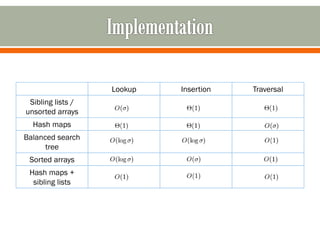
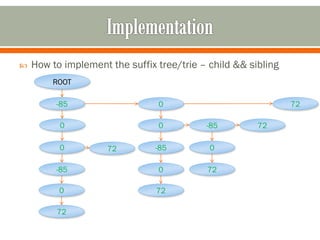
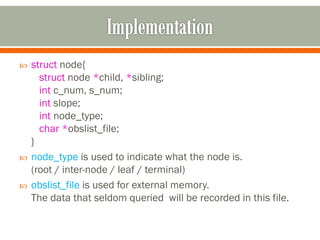

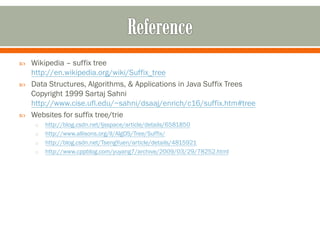
Recommended




























































More Related Content
What's hot (20)








































Viewers also liked (14)




























Recently uploaded (20)






![Fast Screen Recorder v2.1.0.11 Crack Updated [April-2025]](https://cdn.slidesharecdn.com/ss_thumbnails/dataanalysisforbusiness-250322061148-eeff8a831-250401123246-f36be9ca-250401141614-87b01766-thumbnail.jpg?width=560&fit=bounds)
![Fast Screen Recorder v2.1.0.11 Crack Updated [April-2025]](https://cdn.slidesharecdn.com/ss_thumbnails/dataanalysisforbusiness-250322061148-eeff8a831-250401123246-f36be9ca-250401141614-87b01766-thumbnail.jpg?width=560&fit=bounds)
































Introduction of suffix tree
- 1. ? ? pig.sh 120816
- 2. ? Abstract ? Construction ? Implementation ? Reference
- 3. ? Alias: position tree, PAT tree ? Important people o Weiner (1973) first introduction o McCreight (1976) simplified the construction o Ukkonen (1995) fastest construction algorithm o Farach (1997) optimal construction algorithm for all alphabets
- 4. ? Trie ? string: S, length: N ? Suffix tree of S: o the paths from the root to the leaves have a one-to-one relationship with the suffixes of S. o edges spell non-empty strings. o all internal nodes (except perhaps the root) have at least two children -- reference. Wikipedia. Suffix tree
- 5. ? String S = {peeper$}; Suffix(S,0) = {peeper$} ROOT p e e p e r peeper $
- 6. ? String S = {peeper$}; Suffix(S,1) = {eeper$} ROOT p e e e e p p e e r eeper r peeper $ $
- 7. ? String S = {peeper$}; Suffix(S,2) = {eper$} ROOT p e e e p e p e p e r eper e r eeper $ r peeper $ $
- 8. ? String S = {peeper$}; Suffix(S,3) = {per$} ROOT p e e e p e r p e per p e r $ eper e r eeper $ r peeper $ $
- 9. ? String S = {peeper$}; Suffix(S,4) = {er$} ROOT p e e e p r er e r p e per $ p e r $ eper e r eeper $ r peeper $ $
- 10. ? String S = {peeper$}; Suffix(S,5) = {r$} ROOT r p e r e e p r er $ e r p e per $ p e r $ eper e r eeper $ r peeper $ $
- 11. ? However, this isnˇŻt a suffix tree. ItˇŻs a suffix trie. ROOT r p e r e e p r er $ e r p e per $ p e r $ eper e r eeper $ r peeper $ $
- 12. ? Suffix trie can be compressed to suffix tree. ROOT r p e r e e p r er $ e r p e per $ p e r $ eper e r eeper $ r peeper $ $
- 13. ? The suffix tree of {peeper$} is completed. ROOT r pe e r eper r eper per r peeper per eeper eper er $ $ $ $ $ $
- 14. ? There are many ways to implement suffix tree. o Sibling lists / unsorted arrays o Hash maps o Balanced search tree o Sorted array o Hash maps + sibling lists
- 15. Lookup Insertion Traversal Sibling lists / unsorted arrays Hash maps Balanced search tree Sorted arrays Hash maps + sibling lists
- 16. ? How to implement the suffix tree/trie ¨C child && sibling ROOT -85 0 72 0 0 -85 72 0 72 -85 0 -85 0 72 0 72 72
- 17. ? struct node{ struct node *child, *sibling; int c_num, s_num; int slope; int node_type; char *obslist_file; } ? node_type is used to indicate what the node is. (root / inter-node / leaf / terminal) ? obslist_file is used for external memory. The data that seldom queried will be recorded in this file.
- 18. ? If the trie is too big, how can I do? o If trie is constructed by C-S-Link, every subtree is a binary tree. o Record the in-order and pre-/post- order sequence. o Use two sequence to reconstruct, if we want to query the subtree.
- 19. ? Wikipedia ¨C suffix tree http://en.wikipedia.org/wiki/Suffix_tree ? Data Structures, Algorithms, & Applications in Java Suffix Trees Copyright 1999 Sartaj Sahni http://www.cise.ufl.edu/~sahni/dsaaj/enrich/c16/suffix.htm#tree ? Websites for suffix tree/trie o http://blog.csdn.net/ljsspace/article/details/6581850 o http://www.allisons.org/ll/AlgDS/Tree/Suffix/ o http://blog.csdn.net/TsengYuen/article/details/4815921 o http://www.cppblog.com/yuyang7/archive/2009/03/29/78252.html
